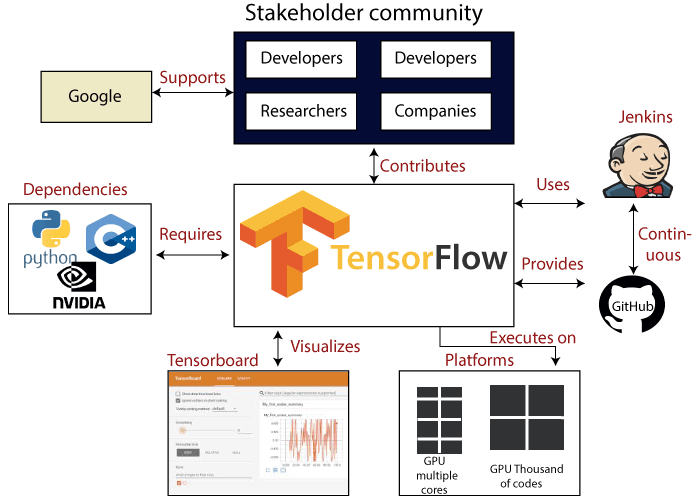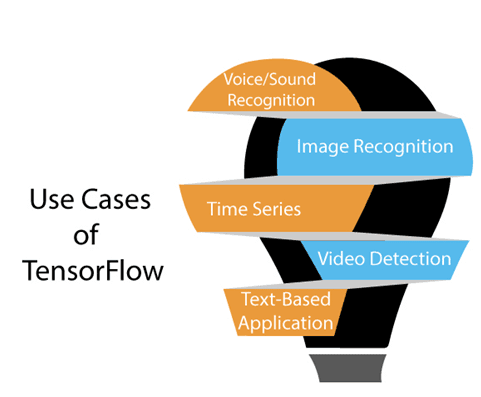Deep learning is changing industries, but choosing the right framework is crucial. Two leaders - Chainer and TensorFlow - each excel in their own way.
Chainer prioritizes flexibility with dynamic graphs allowing seamless experimentation. TensorFlow focuses on scalability and production with extensive tools and community support.
Both offer powerful features, but their strengths suit different needs. Chainer simplifies prototyping with intuitive syntax and ease of debugging evolving models. However, TensorFlow streamlines optimization and deployment with static graphs and a robust ecosystem.
For rapid exploration, Chainer empowers dynamic architectures. But TensorFlow scales efficiently to complex industrial applications.
Both delight developers, yet attract diverse user bases. Chainer attracts researchers who value flexibility. TensorFlow attracts industries requiring scalability and resources.
Ultimately, your goals dictate the framework. Consider your timelines, resources, and collaboration needs. Chainer excels in agile exploration. TensorFlow for stable production.
Whichever you choose, both get the job done, so choose wisely based on your unique situation and needs.
So, let us start with knowing what Chainer vs Tensorflow is.
What are Chainer and TensorFlow?
Machine learning has undergone a sea shift because to deep learning frameworks, which make it simpler for programmers to create and train sophisticated models.
Chainer and TensorFlow are two well-liked frameworks that have grown significantly in popularity.
Chainer: Flexibility and Dynamic Computation
Chainer, developed by Preferred Networks, is known for its flexibility and dynamic computational graph.
With Chainer, you have the freedom to define and modify your neural network architecture on the fly.
This dynamic nature allows for easy debugging and experimentation, making it a favorite among researchers and developers who value flexibility.
TensorFlow: Ecosystem and Scalability

On the other hand, TensorFlow, developed by Google, boasts a robust ecosystem and scalability.
It is simpler to deploy models in production using TensorFlow's extensive range of tools and frameworks. Many experts in the business rely on it because of the wide-ranging assistance from the community and the abundance of pre-trained models.
Now it’s time to see when to choose Chainer.
When to choose Chainer?
Looking for a neural network framework that allows rapid experimentation and flexibility? One that empowers quick iterations and nimble changes to your models?
Then Chainer may be the solution for your needs. Its dynamic computational graph removes barriers to exploration, helping you uncover insights faster.
Flexibility and Dynamic Computation
One of the biggest advantages of Chainer is its flexibility and dynamic computational graph. Unlike static graph frameworks, Chainer allows you to modify your neural network architecture and parameters on the fly. This enables easy debugging, testing of new ideas, and rapid iteration.
Rather than having to define the full model upfront, you can tweak the structure during runtime. Make changes layer by layer and immediately see the effects. No need to re-compile or restart training. This agility makes Chainer ideal for research and prototyping use cases where you want to experiment with different model architectures.
The dynamic graph gives you the freedom to build and refine as you go, accelerating your development cycle.
Rapid Prototyping and Microprojects
Thanks to its straightforward interface and dynamism, Chainer excels at rapid prototyping and small-scale machine learning projects. It has very little boilerplate code compared to other frameworks. This allows you to test out new ideas quickly with minimal overhead.
For smaller datasets and models, Chainer provides an agile environment to build, train, evaluate, and refine your neural network. The easy usage and lack of complexity helps you go from idea to implementation rapidly. If your goal is to prototype models or work on niche microprojects, Chainer is a great match.
Niche Applications
While frameworks like TensorFlow and PyTorch dominate complex production systems, Chainer has found success in specialized domains like natural language processing, computer vision, and reinforcement learning. The dynamic graph is well suited to the needs of researchers in these fields who need to frequently experiment.
For niche applications rather than large-scale development, Chainer's strengths at flexibility and rapid iteration make it an excellent choice. The framework empowers your inner researcher.
Now, after looking into Chainer’s, it’s time to see when to choose TensorFlow.
Suggested Reading:
When to choose TensorFlow?
TensorFlow is a widely acclaimed framework that's designed to make machine learning accessible and efficient.
It offers a rich set of tools, scalability, and a thriving community that can elevate your machine learning endeavors from mere concepts to real-world applications.
Let's explore when TensorFlow is the right choice for your next project.

Production-Ready Deployments
If your project involves large-scale applications or demands robust deployment capabilities, TensorFlow is an excellent option. Its ecosystem is equipped with a diverse range of tools and libraries for model deployment, serving, and monitoring.
This makes TensorFlow ideal for enterprise-level applications that need to be deployed and maintained at scale.
Some key deployment features include TensorFlow Serving for hosting models, TensorFlow.js for web and mobile deployments, and TensorFlow Extended for end-to-end machine learning pipelines.
The scalability of TensorFlow ensures you can efficiently train models on clusters and deploy across distributed systems and devices.
For machine learning engineers working on production-grade systems, TensorFlow provides trusted tools to take models from prototype to production seamlessly. The ecosystem supports the full lifecycle of development, training, deployment, and monitoring.
Strong Community Support and Abundant Resources
TensorFlow boasts a vibrant and active open source community with over 1,500 contributors from various organizations and companies. This means you'll have access to a wealth of resources, tutorials, pre-trained models, and support which can be invaluable when starting out in machine learning.
The official TensorFlow documentation is extensive, providing detailed API references and guides for all skill levels. There are also online courses, blogs, conferences, and an active Stack Overflow community.
This robust support system ensures that TensorFlow stays updated with the latest developments and continually improves over time.
For machine learning practitioners who appreciate having a strong set of resources and community support, TensorFlow delivers in spades. You'll never feel alone on your TensorFlow journey.
Industry Adoption
TensorFlow is widely used by numerous technology companies and businesses, including Google, Airbnb, Uber, and Twitter.
For businesses looking to implement machine learning into their products or services, TensorFlow is a dependable choice given its track record of success across various industries.
The widespread adoption means you'll be using a framework that aligns with industry best practices and has proven results when tackling real-world problems. This can be beneficial if your goal is to work on professional-grade projects or interact with other TensorFlow users in a business setting.
The popularity of TensorFlow provides a strong foundation if you aim to build production-ready systems that can interface with existing infrastructure and teams. It's a framework tailored for enterprise machine learning needs.
Now, let us see how Chainer vs TensorFlow differ from each other.
Suggested Reading:
How do Chainer and TensorFlow differ?
Let us see how different deep learning frameworks work under the hood.
Keep reading to discover the key differences between Chainer and TensorFlow in how they approach model building and optimization.
We'll break down their programming paradigms, graph construction techniques, and optimization methods.
Programming Paradigms
Chainer follows a "define-by-run" approach, where the model structure is defined dynamically during runtime.
On the other hand, TensorFlow follows a "define-and-run" approach, where the model structure is defined statically before execution.
This fundamental difference in programming paradigms affects how you build and modify your models.
Graph Construction
In Chainer, the computational graph is constructed dynamically as you execute your code. This allows for greater flexibility and ease of debugging.
In TensorFlow, the computational graph is constructed upfront, which enables optimizations and efficient execution.
This static graph construction can be beneficial for large-scale deployments.
Optimization Techniques
Chainer and TensorFlow use distinct optimization approaches. Chainer focuses on ease of use and simplicity, allowing you to test out various optimization techniques and tactics.
Contrarily, TensorFlow offers a wealth of tools and optimization techniques that make it simple to fine-tune your models for maximum efficiency.
Conclusion
Whether exploring new ideas or deploying at scale, deep learning frameworks empower innovation.
Chainer and TensorFlow exemplify this, each excelling in their domain. For rapid prototyping, Chainer's flexibility simplifies experimentation.
Meanwhile, TensorFlow's robust ecosystem and scalability streamline production applications. Ultimately, your goals dictate the tool. Consider needs like timelines, resources and collaboration.
Then choose wisely to supercharge your work. Whichever you select, both get results.
So evaluate carefully and pick the framework perfectly suited to your unique situation and vision.
Frequently Asked Questions (FAQs)
What is the main difference between Chainer and TensorFlow?
Chainer uses a dynamic computational graph, while TensorFlow uses a static graph.
Which framework is more beginner-friendly, Chainer or TensorFlow?
TensorFlow tends to be more beginner-friendly due to its extensive documentation and larger community.
Can I use Chainer or TensorFlow for production-level deployments?
Both frameworks can be used for production-level deployments, but TensorFlow's ecosystem and scalability make it a popular choice.
Which framework is better for natural language processing (NLP)?
Chainer is popular for NLP due to its flexibility and support for recurrent neural networks (RNNs).
Can I use Chainer or TensorFlow for computer vision tasks?
Both frameworks are suitable for computer vision tasks and provide tools and libraries for image analysis.


